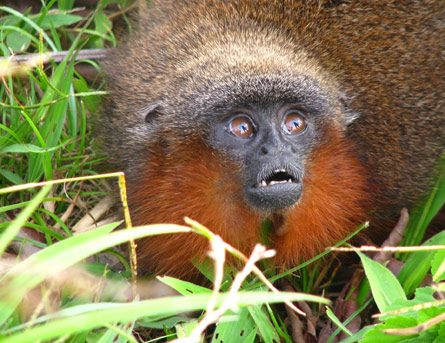 |
| Megatherium reconstruction. Image credit Sloth Sanctuary. |
Saturday 30 August 2014
Identifying the... Mapinguary
Thursday 28 August 2014
The Forés Specimen
 |
| Forés' photograph of the specimen. Image credit Virtual Institute of Cryptozoology. |
TrueAuthority.com's "Quest for the Giant Sloth": An Analysis, part II: Expedition, the Sloth, and DNA Evidence
 |
| Preserved Shasta ground sloth dung. Image credit cindysbeentrippin.com. |
Now, we'll move on to examining the main attraction, is it were: the first actual link on the page (I wanted to get the minor links out of the way in that first post), "The Expedition".
Tuesday 26 August 2014
Identifying the... Milne
 |
| Slightly oversized Arctotherium reconstruction. Image credit Carnivora Forums. |
Rainbow Jaguars and the Ahuizotl Connection
 |
| An artistic recreation of the rainbow jaguar. Image credit Karl Shuker. |
In the field of more strictly Amazonian cryptozoology, there are a number of cryptids similar to the Ahuizotl, but larger.
Monday 25 August 2014
TrueAuthority.com's "Quest for the Giant Sloth": An Analysis, part I: Photography, External Links and John Lewis
 | |||||
| The DNA code from the dung. Perhaps. Image credit TrueAuthority.com. |
Review: Man V. Monster: Brazilian Bigfoot
 | |
| Richard with a two-toed sloth. Image credit National Geographic. |
No episode of the series is available for purchase, physically or digitally, so this review is constructed from memory. Some information may be incorrect or in the wrong chronological order.
Sunday 24 August 2014
TrueAuthority.com's "Quest for the Giant Sloth"
 |
| Image credit TrueAuthority.com |
Saturday 23 August 2014
Uncontacted Tribe Discovered in the Amazon
Earlier in the month, a previously uncontacted tribe emerged from the Amazon, seeking help after a raid by a Colombian drug cartel.
In Brazil, seven naked tribesmen armed with bows emerged, asking for weapons and allies. They claimed that a group of non-Indians, probably drug dealers, attacked their tribe, massacring most of the older men. Many of the younger men caught a respiratory disease from the outsiders, a common problem.
In Peru, about one hundred natives came out from the jungle.
In Brazil, seven naked tribesmen armed with bows emerged, asking for weapons and allies. They claimed that a group of non-Indians, probably drug dealers, attacked their tribe, massacring most of the older men. Many of the younger men caught a respiratory disease from the outsiders, a common problem.
In Peru, about one hundred natives came out from the jungle.
Review: Destination Truth: Flying Dinosaur & Sloth Monster
 |
| Josh with another well-known model Mapinguary. Image credit TVrage.com. |
As is the norm for Destination Truth, the first investigation, the Mapinguary, only takes up half the episode before being replaced by another cryptid - this time the African Kongamato. The beginning of the Mapinguary segment sees Josh visiting the famous Mapinguary statue (and some jaguars at a zoo), and the folklorologist who would later be cut from Beast Man. He also interviews David Oren, who tells him about his ground sloth theory. It seems rather rare for Josh to carry out research and interviews before looking for the animal itself, something which changes for the better in this episode.
Juan Acavar's Sabre-Toothed Cat
 |
| Smilodon recreated in Walking with Beasts. Image credit BBC. |
One very interesting case occurred in Paraguay as recently as 1975. A group of locals, perhaps native Indians, shot a large "mutant jaguar", which was examined by a zoologist named Juan Acavar. Acavar, after examining the body, determined that the animal was a living specimen of Smilodon fatalis. He determined its teeth as being twelve inches long, and it's weight as being one-hundred ans sixty pounds.
To avoid causing paranoia and mass hysteria, Acavar stuck with the mutant jaguar identification.
Recently, there has been speculation that the animal may have instead been Thylacosmilus, a marsupial analogue to Smilodon. However, this animal (supposedly) went extinct in the Early Pliocene, and had highly distinctive flanges on its lower jaw, something which Acavar presumably would have commented upon.
The cadaver, unfortunately, was apparently not preserved, as nothing of it or Acavar has been heard since the shooting. It is entirely possible that the animal was, in fact, a mutant jaguar - though it seems Acavar, an experienced zoologist, would have been able to work this out should it have been the case.
Read more about sabre-toothed cats in the Amazon.
Notes and references
Shuker, Karl (1989) Mystery Cats of the World. ISBN 978-0709037064
Review: Beast Man: Nightmare of the Amazon
 |
| Pat with a well-known Mapinguary model in the city. Image credit National Geographic. |
The series follows biologist Pat Spain, great-nephew of Charles Fort, as he travels to five different locations around the world, searching for the local cryptid. Fort was an American scientist who researched phenomena such as ball lightning and raining fish, which were dismissed in his time but are now known to be fact.
Amazon Expeditions Since 2010 Discover at Least 441 New Species
 | |||
| Caqueta titi monkey or Callicebus caquetensis, a 'purring' monkey. Image credit The Guardian. |
Subscribe to:
Posts (Atom)
